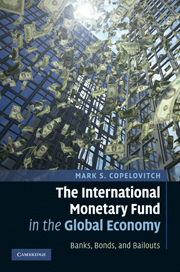Book contents
- Frontmatter
- Contents
- List of figures
- List of tables
- Preface
- 1 The International Monetary Fund in the global economy
- 2 Global finance and the politics of IMF lending: theory
- 3 Global finance and the politics of IMF lending: evidence
- 4 Global finance and IMF lending to Mexico, 1983–1995
- 5 Global finance and IMF lending to South Korea, 1983–1997
- 6 Conclusions
- Appendices
- References
- Index
2 - Global finance and the politics of IMF lending: theory
Published online by Cambridge University Press: 06 July 2010
- Frontmatter
- Contents
- List of figures
- List of tables
- Preface
- 1 The International Monetary Fund in the global economy
- 2 Global finance and the politics of IMF lending: theory
- 3 Global finance and the politics of IMF lending: evidence
- 4 Global finance and IMF lending to Mexico, 1983–1995
- 5 Global finance and IMF lending to South Korea, 1983–1997
- 6 Conclusions
- Appendices
- References
- Index
Summary
In this chapter, I develop in greater detail my argument that changes in the composition of international capital flows constitute the key factor explaining variation in the International Monetary Fund's lending policies. I begin by discussing the key dimensions of variation in financial globalization in the contemporary world economy. Specifically, I illustrate the substantial changes in the composition of borrowers and lenders in international finance during the last two decades, as well as the sizeable variation in the geographic distribution of private international creditors. After outlining these changes in the composition of developing countries' international debt, I then discuss the IMF decision-making process in detail. Drawing on principal–agent theories of international institutions, I develop a “common agency” theory of IMF policymaking in which two key actors – the Fund's largest member states (the “collective principal”) and the IMF's bureaucratic staff (the “agent”) – jointly determine lending decisions. In contrast to most existing theories of IMF lending, this framework explicitly accounts for both actors' key roles in Fund policymaking. Moreover, it also takes into account the importance of preference heterogeneity among the Fund's principals in shaping IMF lending decisions. Finally, using this common agency framework, I explain how changes in the composition of private international capital flows shape the politics of IMF lending. I develop a set of testable hypotheses linking changes in private international debt composition to variation in the preferences of both the Fund's largest shareholder countries and the IMF staff over the size and terms of Fund lending arrangements.
- Type
- Chapter
- Information
- The International Monetary Fund in the Global EconomyBanks, Bonds, and Bailouts, pp. 29 - 67Publisher: Cambridge University PressPrint publication year: 2010



